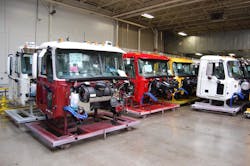It’s so very hard to get a solid read on the direction of truck sales for 2016 – or trailer sales, for that matter. Most of the forecasts to date are fairly rosy (go here, here and here for some of those) while others expect truck and trailer sales to start sliding down next year.
The latest medium- and heavy-duty truck order data offered up by ACT Research, though, seems to indicate that the “peak time” for truck sales may indeed be behind us – with lower numbers dead ahead.For the month of October, ACT noted that 47,200 Class 5-8 orders were booked, up 14% from September but down 30% compared to same month in 2014 – though orders in October 2014 were record-setting to a degree, especially for Class 8 units.
At 25,200 units in October, North American Class 8 net orders fell 45% short year-over-year, noted Kenny Vieth, ACT’s president and senior analyst, yet “remember that October 2014 was the second-best ever Class 8 order month, so the year-over-year comparison is a tough one.”. When seasonally adjusted, preliminary Class 8 net orders were down only 3% from September, he stressed.
In terms of North American Class 5-7 units, net orders clocked in at 22,000 for October. “Despite tough comparisons, down 1.8% year-over-year and 0.3% month-over-month, both are within the margin of error for preliminary industry data,” Vieth added.Don Ake (seen at left), VP of commercial vehicles at research firm FTR, declared that the fall order season “has gotten off to a mediocre start this year,” though he stressed that while orders were not that great, but they weren’t terrible either.
“It is not time to panic just yet,” Ake pointed out “Fleets are being more cautious this year in their ordering, which is to be expected considering the weak GDP [gross domestic product] numbers and slower manufacturing growth. If November and December orders are in the same range [as October] then 2016 production should meet expectations.”
Ake also emphasized that North American Class 8 orders for the last 12 months remain a still-impressive 324,000.
“Overall, [the order] backlog remains strong, helping to keep the market propped up,” he noted. “On the other hand, there was an uneven distribution of these orders among the OEM’s, which unfortunately could result in upcoming production cuts at some plants being more than expected.”
That being said, though, Michael Baudendistel – an analyst with Stifel Financial Corp. – is taking something of a dimmer view where those order volumes are concerned.“We consider October orders to be one of the most critical months for this data because it is an early indication of order trends for the 2015-2016 order season and 2016 production,” he explained.
“The data for medium duty equipment is roughly in line with our expectations while Class 8 orders were below our expectations, giving us added confidence in our view that 2016 Class 8 production will be well below 2015 production levels.”
As a result, Stifel is estimating a decrease of 15% year-over-year in North American Class 8 production from the expected 330,000 units this year to 280,000 units in 2016.
The firm also outlined some of the factors it thinks are holding orders and eventual sales of commercial vehicles:
- Freight volumes have softened in recent months, particularly for industrial freight,
- Used tractor prices are falling and expected to fall further,
- Average equipment ages that are lower than one year ago,
- Lower diesel prices which lessens the incentive to upgrade to the newest equipment for the purposes of maximizing miles per gallon (MPG),
- Class 8 retail inventories that are roughly 20% higher than they were one year ago.
“Nevertheless, we believe our outlook for relative stability in medium duty remains intact,” he explained. “The demand drivers for medium duty equipment are relatively stable and the medium duty market did not experience production that was significantly above replacement demand levels recently, as was the case for heavy duty equipment.”
Yet back on the Class 8 beat, Baudendistel said a “few questions” remain as to what happens regarding eventual sales volumes into 2016.
“Among them is whether the net orders included a great deal of cancelations or whether cancelations returned to a low level after the uptick seen in late summer/early fall,” he pointed out.
“In addition, we believe it is possible that many voluminous deals between large fleets and OEMs may not have been finalized during the month of October, so we could see a sequential uptick in orders in November.”
We’ll have to wait a few more weeks for some answers.




